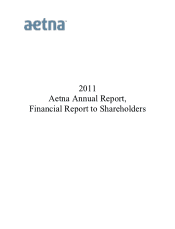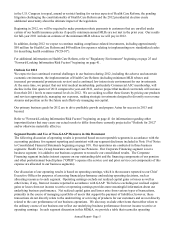Aetna 2011 Annual Report Download - page 11
Download and view the complete annual report
Please find page 11 of the 2011 Aetna annual report below. You can navigate through the pages in the report by either clicking on the pages listed below, or by using the keyword search tool below to find specific information within the annual report.Annual Report- Page 5
in the U.S. Congress to repeal, amend or restrict funding for various aspects of Health Care Reform, the pending
litigation challenging the constitutionality of Health Care Reform and the 2012 presidential election create
additional uncertainty about the ultimate impact of the legislation.
Beginning in 2012, we will be required to make premium rebate payments to customers that are enrolled under
certain of our health insurance policies if specific minimum annual MLRs are not met in the prior year. Our results
for full-year 2011 include an estimate of the minimum MLR rebates we will pay in 2012.
In addition, during 2012 we expect to continue making compliance-related investments, including approximately
$50 million for Health Care Reform and $40 million for expenses relating to implementing new standardized codes
for describing health conditions ("ICD-10").
For additional information on Health Care Reform, refer to "Regulatory Environment" beginning on page 25 and
"Forward-Looking Information/Risk Factors" beginning on page 41.
Outlook for 2012
We expect to face continued external challenges in our business during 2012, including the adverse and uncertain
economic environment, the implementation of Health Care Reform (including minimum MLR rebates and
increased governmental premium rate review) and a continued low interest rate environment for our investments.
At the same time, we project that our total medical membership, particularly Commercial ASC membership, will
decline in the first quarter of 2012 compared to year-end 2011, and we project that medical cost trends will increase
from their 2011 levels to more normal levels in 2012. We are seeking to offset these factors by pricing our products
and services appropriately, managing our expenses, making strategic investments designed to diversify our revenue
streams and position us for the future and effectively managing our capital.
Our primary business goals for 2012 are to drive profitable growth and prepare Aetna for success in 2013 and
beyond.
Refer to "Forward-Looking Information/Risk Factors" beginning on page 41 for information regarding other
important factors that may cause our actual results to differ from those currently projected in "Outlook for 2012"
and/or otherwise materially affect us.
Segment Results and Use of Non-GAAP Measures in this Document
The following discussion of operating results is presented based on our reportable segments in accordance with the
accounting guidance for segment reporting and consistent with our segment disclosure included in Note 19 of Notes
to Consolidated Financial Statements beginning on page 108. Our operations are conducted in three business
segments: Health Care, Group Insurance and Large Case Pensions. Our Corporate Financing segment is not a
business segment; it is added to our business segments to reconcile our consolidated results. The Corporate
Financing segment includes interest expense on our outstanding debt and the financing components of our pension
and other postretirement benefit plans (“OPEB”) expense (the service cost and prior service cost components of this
expense are allocated to our business segments).
Our discussion of our operating results is based on operating earnings, which is the measure reported to our Chief
Executive Officer for purposes of assessing financial performance and making operating decisions, such as
allocating resources to each segment. Operating earnings exclude net realized capital gains or losses as well as
other items, if any, from net income reported in accordance with GAAP. We believe excluding net realized capital
gains or losses from net income to arrive at operating earnings provides more meaningful information about our
underlying business performance. Net realized capital gains and losses arise from various types of transactions,
primarily in the course of managing a portfolio of assets that support the payment of liabilities; however, these
transactions do not directly relate to the underwriting or servicing of products for our customers and are not directly
related to the core performance of our business operations. We also may exclude other items that neither relate to
the ordinary course of our business nor reflect our underlying business performance from net income to arrive at
operating earnings. In each segment discussion in this MD&A, we provide a table that reconciles operating
























